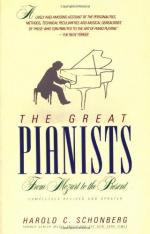|
This section contains 503 words (approx. 2 pages at 400 words per page) |

|
Chapters VI and VII Summary and Analysis
Chapters VI and VII covers the bridge period from classicism to romanticism.
Chapter VI In the Interim describes the last two decades of the eighteenth century when a number of pianists performed in a manner that bridged classicism to romanticism. This transition began with Johann Hummel, followed by John Field, Kalkbrenner, von Weber, Czerny and Ignaz Moscheles by 1794. At the same time, pianos manufactured annually increased from twenty or so high quality, pricey English or Viennese units per producer to a smaller, less resonant and lower priced four hundred by 1802, and fifteen hundred by Broadwood alone in 1825 as manufacturing tools and techniques improved. From 1750 to 1824, London music shops grew from 12 to 150. Piano-playing techniques changed from Clementi's classic horizontal hand and arm level to outward-turned hands and wrists by Hummel and others. Devices and mechanisms were...
(read more from the Chapters VI and VII Summary)
|
This section contains 503 words (approx. 2 pages at 400 words per page) |

|




